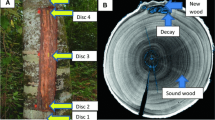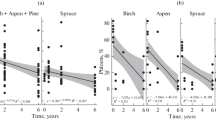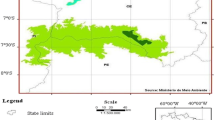Abstract
Bark and exudates are widely commercialized non-timber forest products. However, the ecological impacts of the harvesting of these products have seldom been studied. The aim of this study is to investigate the relationship of tree resilience to harvesting intensity in Himatanthus drasticus, a tree that is highly exploited in the Brazilian savanna (Cerrado) for its medicinal latex. Although the traded product is the latex, the traditional harvesting systems involve the removal of the bark of the trees to allow exploitation. A 3-year experiment was conducted in two different Cerrado ecosystems (open savanna and savanna woodland). Trees were debarked at four debarking intensities to simulate the effects of traditional management systems. Measurements of bark growth were taken every 6 months, and quantitative and qualitative indexes of bark regeneration were obtained. The mortality of the debarked trees was low and could not be related to the intensity of harvesting. No signs of attack by fungi or insects were recorded. Compared with other species exploited for bark, H. drasticus is very resilient to harvesting; however, bark regeneration is relatively slow. In both analyzed ecosystems, the regeneration indexes showed higher values in the controls than in the treatments, indicating that 3 years is not sufficient for total recovery of the rhytidome. Bark regeneration occurred primarily by sheet growth and was more rapid in open savanna than in savanna woodland. No differences in the rate of bark recovery were found among management treatments. Based on the results, sustainable harvesting guidelines are suggested for the species.



Similar content being viewed by others
References
Baldauf, C., & Santos, F. A. M. (2013). Ethnobotany, traditional knowledge, and diachronic changes in non-timber forest products management: the case study of Himatanthus drasticus (Apocynaceae) in the Brazilian Savanna. Economic Botany, 67(2), 110–120.
Borges Filho, H. C., & Felfili, J. M. (2003). Avaliação dos níveis de extrativismo da casca de barbatimão [Stryphnodendron adstringens (Mart.) Coville] no Distrito Federal, Brasil. Revista Árvore, 27(5), 735–745.
Botha, J., Witkowski, E., & Shackleton, C. (2004). The impact of commercial harvesting on Warburgia salutaris (‘pepper-bark tree’) in Mpumalanga, South Africa. Biodiversity and Conservation, 13(9), 1675–1698.
Cardoso, M. R. C. (2010). Desenvolvimento rural e sustentabilidade-o caso da mesorregião Chapada do Araripe. Brasília: Universidade de Brasílila.
Catry, F. X., Moreira, F., Pausas, J. G., Fernandes, P. M., Rego, F., Cardillo, E., et al. (2012). Cork oak vulnerability to fire: the role of bark harvesting, tree characteristics and abiotic factors. PLoS ONE, 7(6), e39810.
Cavalcanti, A. C., & Lopes, O. F. (1994). Condições edafoclimáticas da Chapada do Araripe e viabilidade de produção sustentável de culturas. Brasília: EMBRAPA-SPI.
Chungu, D., Muimba-Kankolongo, A., Roux, J., & Malambo, F. (2007). Bark removal for medicinal use predisposes indigenous forest trees to wood degradation in Zambia. Southern Hemisphere Forestry Journal, 69(3), 157–163.
Clark, D. A., & Clark, D. B. (1992). Life history diversity of canopy and emergent trees in a neotropical rain forest. Ecological Monographs, 62(3), 315–344.
Cocks, M., López, C., & Dold, T. (2011). Cultural importance of non-timber forest products: opportunities they pose for bio-cultural diversity in dynamic societies. In S. Shackleton, C. Shackleton, & P. Shanley (Eds.), Non-timber forest products (pp. 107–128). Berlin: Springer.
Cocks, M. L., & Dold, A. P. (2006). Cultural significance of biodiversity: the role of medicinal plants in urban African cultural practices in the Eastern Cape, South Africa. Journal of Ethnobiology, 26(1), 60–81.
Cunningham, A. (2001). Applied ethnobotany. People and plants conservation manual. London: Earthscan Publications Ltd.
Cunningham, A., & Mbenkum, F. (1993). Sustainability of harvesting Prunus africana bark in Cameroon. People and Plants Working Paper, 2, 28. Paris.
Delvaux, C. (2009). “Strip-trees”: the life after: responses to bark harvesting of medicinal tree species from Forêt Classée Des Monts Kouffé, Benin. University of Ghent.
Delvaux, C., Sinsin, B., Darchambeau, F., & Van Damme, P. (2009). Recovery from bark harvesting of 12 medicinal tree species in Benin, West Africa. Journal of Applied Ecology, 46(3), 703–712.
Delvaux, C., Sinsin, B., & Van Damme, P. (2010). Impact of season, stem diameter and intensity of debarking on survival and bark re-growth pattern of medicinal tree species, Benin, West Africa. Biological Conservation, 143(11), 2664–2671.
Di Stasi, L. C. (1996). Plantas medicinais: arte e ciência: um guia de estudo interdisciplinar: Ed. Estadual Paulista: UNESP-Univ.
Diederichs, N., McKean, S., & Wynberg, R. P. (2006). Conservation and trade regulations for medicinal plants. In N. Diederichs (Ed.), commercialising medicinal plants: a Southern African guide (pp. 9–19). Stellenbosh: Sun Press.
Dujesiefken, D., & Liese, W. (1990). Einfluß der Verletzungszeit auf die Wundheilung bei Buche (Fagus sylvatica L.). Holz als Roh- und Werkstoff, 48(3), 95–99.
Dytham, C. (2011). Choosing and using statistics: a biologist’s guide. Oxford: Wiley-Blackwell.
Efferth, T., & Greten, H. J. (2012). Medicinal and aromatic plant research in the 21st century. Medicinal and Aromatic Plants, 1, e110.
Fasola, T. R., & Egunyomi, A. (2005). Nigerian usage of bark in phytomedicine. Ethnobotany Research and Applications, 3, 073–077.
Felfili, J., & Junior, M. S. (1988). Distribuição dos diâmetros numa faixa de cerrado na fazenda Água Limpa em Brasília-DF. Acta Botanica Brasilica, 2(1–2), 85–104.
Fisher, J. B. (1981). Wound-healing by exposed secondary xylem in Adansonia (Bombacaceae). IAWA Bulletin, 2, 193–199.
Freitas, A. V. L., Coelho, M. F. B., Maia, S. S. S., & Azevedo, R. A. B. (2012). Plantas medicinais: um estudo etnobotânico nos quintais do Sítio Cruz, São Miguel, Rio Grande do Norte, Brasil. Revista Brasileira de Biociências, 10(1), 48.
Gaoue, O. G., & Ticktin, T. (2007). Impacts of bark and foliage harvest on Khaya senegalensis (Meliaceae) reproductive performance in Benin. Journal of Applied Ecology, 45(1), 34–40.
Geldenhuys, C. J., & Mitchell, D. (2006). Sustainable harvesting technologies. In N. Diederichs (Ed.), Commercializing medicinal plants: a Southern African guide (pp. 23–39). Stellenbosh: Sun Press.
Geldenhuys, C. J., Syampungani, S., Meke, G. S., & Vermeulen, W. J. (2007). Response of different species to bark harvesting for traditional medicine in Southern Africa. In J. J. Bester, A. H. W. Seydack, T. Vorster, I. J. Van der Merwe, & S. Dzivhani (Eds.), Multiple use management of natural forests and woodlands: policy refinement and scientific progress (pp. 55–62). Pretoria: Department of Water Affairs and Forestry.
Guariguata, M. R., & Gilbert, G. S. (1996). Interspecific variation in rates of trunk wound closure in a Panamanian lowland forest. Biotropica, 28(1), 23–29.
Guedje, N. M., Lejoly, J., Nkongmeneck, B.-A., & Jonkers, W. B. (2003). Population dynamics of Garcinia lucida (Clusiaceae) in Cameroonian Atlantic forests. Forest Ecology and Management, 177(1), 231–241.
Guedje, N. M., Zuidema, P. A., During, H., Foahom, B., & Lejoly, J. (2007). Tree bark as a non-timber forest product: the effect of bark collection on population structure and dynamics of Garcinia lucida Vesque. Forest Ecology and Management, 240(1), 1–12.
Hall, J. B., O’Brien, E. M., & Sinclair, F. L. (2000). Prunus africana: a monograph (vol. 18). Bangor: University of Wales, School of Agricultural and Forest Sciences
Haq, F., Ahmad, H., & Alam, M. (2011). Traditional uses of medicinal plants of Nandiar Khuwarr catchment (District Battagram), Pakistan. Journal of Medicinal Plants Research, 5, 39–48.
Hare, R. C. (1965). Contribution of bark to fire resistance of southern trees. Journal of Forestry, 63(4), 248–251.
Juan, D., Hong-Li, X., De-Qiang, Z., Xin-Qiang, H., Min-Jie, W., Ying-Zhang, L., et al. (2006). Regeneration of the secondary vascular system in poplar as a novel system to investigate gene expression by a proteomic approach. Proteomics, 6(3), 881–895.
Kathe, W. (2006). Revision of the “Guidelines on the conservation of medicinal plants” by WHO, IUCN, WWF AND TRAFFIC In R. J. Bogers, L. E. Craker, & D. Lange (Eds.), Medicinal and aromatic plants (pp. 109–120): Springer.
Köppen, W. (1948). Climatologia: con un estudio de los climas de la tierra. Fondo de Cultura Econômica (pp. 479).
Laird, S. A., McLain, R. J., & Wynberg, R. P. (2010). Wild product governance: finding policies that work for non-timber forest products. London: Earthscan/James & James.
Leaman, D. J. (2004). The global strategy for plant conservation—what can it mean for medicinal plants? Newsletter of the Medicinal Plant Specialist Group, 9/10.
Lucetti, D. L., Lucetti, E. C., Bandeira M. A., Veras, H. N., Silva, A. H., Leal, L. K., et al. (2010). Anti-inflammatory effects and possible mechanism of action of lupeol acetate isolated from Himatanthus drasticus (Mart.) Plumel. Journal of Inflammation, 7, 60.
Malviya, J., Joshi, V., & Singh, K. (2012). Antimicrobial activity of some ethno-medicinal plants used by Baiga Tribes from Amarkantak, India. Advances in Life Science and Technology, 4, 19–26.
Mariot, A. (2008). Fundamentos para o manejo de populações naturais de Drimys brasiliensis Miers-Winteraceae. Florianópolis: Universidade Federal de Santa Catarina.
MDA. (2010). In M. D. Agrário (Ed.), Plano Territorial de Desenvolvimento Rural Sustentável: Território Cidadania do Cariri (p. 348). Fortaleza: Instituto Agropolos do Ceará.
MMA. (2007). Áreas prioritárias para a conservação, uso sustentável e repartição de benefícios da biodiversidade brasileira: atualização - Portaria MMA Nº 09, 23 de janeiro de 2007. (pp. 300). Brasília: MMA/SBF.
Monteiro, J. M., Lins Neto, E. M., Araújo, E. L., Amorim, E. L., & Albuquerque, U. P. (2011). Bark regeneration and tannin content in Myracrodruon urundeuva Allemão after simulation of extractive damages—implications to management. Environmental Monitoring and Assessment, 180(1), 31–39.
Mousinho, K. C., Oliveira, C. C., Ferreira, J. R. d. O., Carvalho, A. A., Magalhães, H. I. F., Bezerra, D. P., et al. (2011). Antitumor effect of laticifer proteins of Himatanthus drasticus (Mart.) Plumel–Apocynaceae. Journal of ethnopharmacology, 137(1), 421–426.
Neely, D. (1988). Wound closure rates on trees. Journal of Arboriculture, 14, 250–254.
Oliveira, P. S., & Marquis, R. J. (2002). The cerrados of Brazil: ecology and natural history of a neotropical savanna. New York: Columbia Univ Press.
Pandey, A. K., & Mandal, A. K. (2012). Sustainable harvesting of Terminalia arjuna (Roxb.) Wight & Arnot (Arjuna) and Litsea glutinosa (Lour.) Robinson (Maida) bark in Central India. Journal of Sustainable Forestry, 31(3), 294–309.
Pandey, A. K., & Yadav, S. (2010). Variation in gymnemic acid content and non-destructive harvesting of Gymnema sylvestre (Gudmar). Pharmacognosy Research, 2(5), 309.
Prance, G. T., & Prance, A. E. (1993). Bark. Portland: Timber Press.
Puritch, G. S., & Mullick, D. B. (1975). Effect of water stress on the rate of non-suberized impervious tissue formation following wounding in Abies grandis. Journal of Experimental Botany, 26(6), 903–910.
R Development Core Team (2012). R: a language and environment for statistical computing. R Foundation for Statistical Computing, Vienna, Austria. http://www.R-project.org.
Rani, P., & Khullar, N. (2004). Antimicrobial evaluation of some medicinal plants for their anti-enteric potential against multi-drug resistant Salmonella typhi. Phytotherapy Research, 18(8), 670–673.
Romero, C. (2006). Tree responses to stem damage. University of Florida.
Romero, C., & Bolker, B. M. (2008). Effects of stem anatomical and structural traits on responses to stem damage: an experimental study in the Bolivian Amazon. Canadian Journal of Forest Research, 38(3), 611–618.
Schippmann, U., Leaman, D., & Cunningham, A. B. (2006). A comparison of cultivation and wild collection of medicinal and aromatic plants under sustainability aspects. In R. J. Bogers, L. E. C. L.E., & L. D. (Eds.), Medicinal and aromatic plants (vol. 17, pp. 75–95). Dordrecht: Springer.
Schoonenberg, T., Pinard, M., & Woodward, S. (2003). Responses to mechanical wounding and fire in tree species characteristic of seasonally dry tropical forest of Bolivia. Canadian Journal of Forest Research, 33(2), 330–338.
Shanley, P., & Luz, L. (2003). Eastern Amazonian medicinals: marketing, use and implications of forest loss. BioScience, 53(6), 573–584.
Shanley, P., Pierce, A. R., Laird, S. A., & Guillén, A. (2002). Tapping the green market: certification and management of non-timber forest products. London: Earthscan/James & James.
Silva, J. R. A., Rezende, C. M., Pinto, Â. C., Pinheiro, M. L., Cordeiro, M. C., Tamborini, E., et al. (1998). Triterpenic esters from Himatanthus sucuuba (Spruce) Woodson. Quimica Nova, 21(6), 702–704.
Sousa, E. L. d., Grangeiro, A. R. S., Bastos, I. V. G. A., Rodrigues, G. C. R., Anjos, F. B. R. d., Souza, I. A. d., et al. (2010). Antitumor activity of leaves of Himatanthus drasticus (Mart.) Plumel-Apocynaceae (janaguba) in the treatment of Sarcoma 180 tumor. Brazilian Journal of Pharmaceutical Sciences, 46(2), 199–203.
Souza, W., Stinghen, A., & Santos, C. (2004). Antimicrobial activity of alkaloidal fraction from barks of Himatanthus lancifolius. Fitoterapia, 75(7), 750–753.
Spina, A. P. (2004). Estudos taxonômico, micro-morfológico e filogenético do gênero Himatanthus Willd. ex Schult. (Apocynaceae: Rauvolfioideae-Plumerieae). Universidade Estadual de Campinas.
Stewart, K. (2009). Effects of bark harvest and other human activity on populations of the African cherry (Prunus africana) on Mount Oku, Cameroon. Forest Ecology and Management, 258(7), 1121–1128.
Stobbe, H., Schmitt, U., Eckstein, D., & Dujesiefken, D. (2002). Developmental stages and fine structure of surface callus formed after debarking of living lime trees (Tilia sp.). Annals of Botany, 89, 773–782.
Suleman, S., & Alemu, T. (2012). A survey on utilization of ethnomedicinal plants in Nekemte Town, East Wellega (Oromia), Ethiopia. Journal of Herbs, Spices & Medicinal Plants, 18(1), 34–57.
Sunderland, T. C. H., & Tako, C. T. (1999). The exploitation of Prunus africana on the island of Bioko, Equatorial Guinea—a report for the People and Plants Initiative. In IUCN/SSC (Ed.), Medicinal Plant Specialist Group. Bonn.
Ticktin, T., & Shackleton, C. (2011). Harvesting non-timber forest products sustainably: opportunities and challenges. In S. Shackleton, C. Shackleton, & P. Shanley (Eds.), Non-timber forest products in the global context (pp. 149–169). Heidelberg: Springer.
Toledo, B., Galetto, L., & Colantonio, S. (2009). Ethnobotanical knowledge in rural communities of Cordoba (Argentina): the importance of cultural and biogeographical factors. Journal of Ethnobiology and Ethnomedicine, 5(1), 40.
Uniyal, S. K. (2013). Bark removal and population structure of Taxus wallichiana Zucc. in a temperate mixed conifer forest of western Himalaya. Environmental Monitoring and Assessment, 185(4), 2921–2928.
Vermeulen, W., & Geldenhuys, C. (2004). Experimental protocols and lessons learnt from strip harvesting of bark for medicinal use in the southern Cape forests. FRP-DFID Project R8305 Report (pp. 14). UK: Wild Resources Limited.
WHO (1993). Guidelines on the conservation of medicinal plants. Geneva: World Health Organization.
WHO (2001). General guidelines for methodologies on research and evaluation of traditional medicine. Geneva: World Health Organization.
WHO (2002). Traditional medicine strategy 2002–2005. Geneva: World Health Organization.
WHO (2003). WHO guidelines on Good Agricultural and Field Collection Practices (GACP) for medicinal plants. Geneva: World Health Organization.
Zardo, R. N., & Henriques, R. P. B. (2011). Growth and fruit production of the tree Caryocar brasiliense in the Cerrado of central Brazil. Agroforestry Systems, 82(1), 15–23.
Acknowledgments
The authors thank the Biodiversity Program Brazil-Italy (PBBI) for financial and logistic support; the National Council of Technological and Scientific Development (CNPq) for supporting this research with the Edital Universal (Process 472127/2008-0), a PhD fellowship granted to C.B. (Process 140813/2008-0) and a research productivity fellowship granted to F.A.M.S. (Process 308748/2010-7); the São Paulo Research Foundation (FAPESP) for a research grant (Process 2008/08737-4); the students of the “Janaguba project” and the FLONA-Araripe staff for field support; Manuel Guariguata for references and discussions on bark harvesting; and Julia Caram Sfair for her support and suggestions about the analyses.
Author information
Authors and Affiliations
Corresponding author
Rights and permissions
About this article
Cite this article
Baldauf, C., dos Santos, F.A.M. The effect of management systems and ecosystem types on bark regeneration in Himatanthus drasticus (Apocynaceae): recommendations for sustainable harvesting. Environ Monit Assess 186, 349–359 (2014). https://doi.org/10.1007/s10661-013-3378-x
Received:
Accepted:
Published:
Issue Date:
DOI: https://doi.org/10.1007/s10661-013-3378-x




